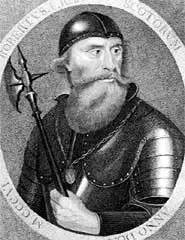Robert Bruce
Robert The Bruce
Robert the Bruce or Robert I was the King of Scots during the early 14th century. He was a great military leader and perhaps the best known Scottish hero of all times.
He led the Scots in the Scottish War for Independence against English forces under Edward I and Edward II.
His single most notable achievement was securing Scotland’s independence, for which he is revered in his country, even to this day.


Early Life: Robert was born on July 11, 1274 in Ayrshire. His father was Robert de Brus, 6th Lord of Annandale. Robert was also a fourth great grandson of David I, King of Scots. His mother, Marjorie was a fearsome woman who was also the Countess of Carrick. Robert had nine siblings and was the third eldest child of his parents.
During his childhood, Robert kept moving between Annandale and Ayrshire, head of his mother’s earldom of Carrick.
In 1292, Edward I appointed John Ballioli, a first cousin of Robert’s grandfather as King of Scotland. After his accession, Robert’s father became Lord of Annandale and Robert became Earl of Carrick.
When the relations between Edward I and John Ballioli deteriorated, Bruces supported Edward I against John.
Later, the Bruces had to move away from Scotland after the Scottish nobles led by John Comyn, turned against them and seized their estates at Carrick and Annandale. Edward I provided refuge to Robert and his family and gave them command of Carlisle Castle.
Start of War of Independence: In 1296, Comyn led Scottish forces attacked Carlisle castle. Edward I considered it an attack on England and invaded Scotland the same year. He inflicted crushing defeat on Scotts in Battle of Dunbar. He deposed King John and imprisoned him in Tower of London. Bruces were given back control of Annandale and Carrick and swore allegiance to Edward I.
In 1297, Robert Bruce, in a surprising move joined the Scottish revolt against tyrannical rule of English in Scotland. In 1298, Edward defeated Scots led by William Wallace in the Battle of Falkirk. In 1301, Edward embarked on another campaign in Scotland but achieved little against Scots and a truce was signed between the two sides after which Bruce yet again joined Edward’s camp.
In 1303, Edward launched yet another campaign in Scotland and invaded vast tracts of land. All Scottish nobles, except William Wallace surrendered to Edwards.
In 1305, William Wallace was captured and executed by English. In 1306, after a heated scuffle, Robert killed John Comyn, the most powerful noble in Scotland and Robert’s arch nemesis. Six weeks later he became King of Scotland.

Reign: In 1307, Edward I died and was succeeded by his son Edward II. Robert Bruce continued his efforts to secure independence from English. In 1309, he established his parliament and also strengthened his control over all Scottish territory north of River Tay.
In the next three years, Robert secured several victories against English and retook control of many outposts and castles. In 1314, Bruce secured a momentous victory against English in the Battle of Bannockburn. This victory spelled independence from English rule for Scotts. Bruce later campaigned in Northern England to strengthen his control. He also started a campaign inside Ireland to assist them in securing their own independence from the English.
Yep, despite early successes, this campaign failed to garner support from Irish tribes who eyed Scots with suspicion. Robert Bruce’s biggest diplomatic achievement was signing of Treaty of Edinburgh-Northampton with Edward III of England.
This treaty recognized Scotland as an independent country with Robert Bruce as its legitimate ruler.

Later Life and Death: Robert the Bruce kept a frail health during his last years. Its reported that he suffered from leprosy or a similar skin disease. Robert breathed his last on June 7, 1329 at Manor of Cardross near Dumbarton. He was buried in Dunfermline Abbey in Fife, Scotland. He was then succeeded by his minor son, David II as King of Scotland.




